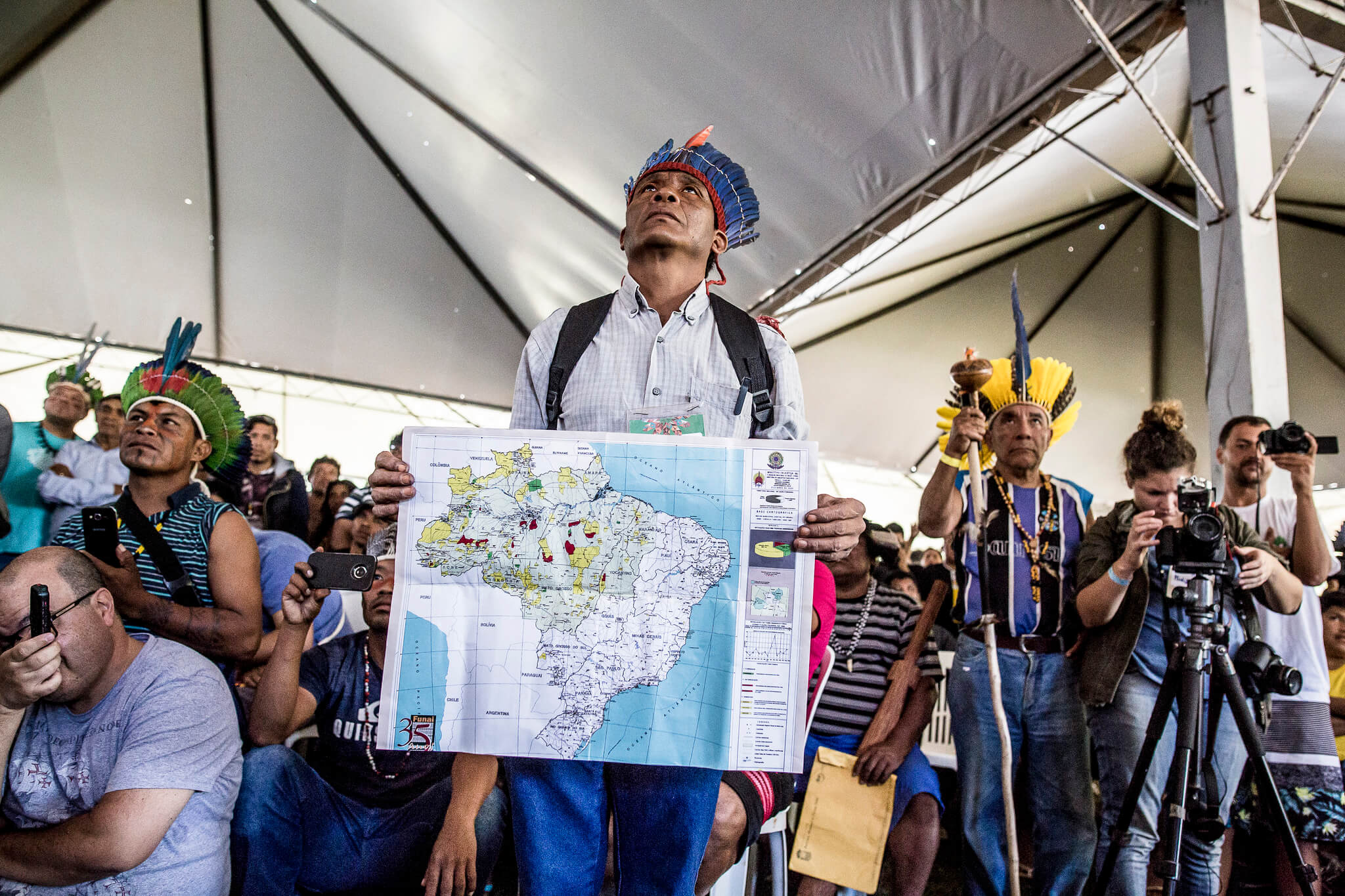
by Deep Green Resistance News Service | Jun 14, 2018 | Protests & Symbolic Acts
Featured image: Photo: Mídia NINJA/flickr (Some Rights Reserved). Political setbacks in Brazil give renewed thrust to annual mobilization for land rights.
The camp smelled like smoke and urucum, a plant used for body painting. A defiant energy pulsed through the crowd. We could hear chants, ritual mantras, and ceremonial crying.
The place resounded with the voices of the more than 3,000 indigenous people from more than 100 different groups from all over Brazil, who gathered for the five-day 2018 National Indigenous Mobilization, held from April 23 to 27 in Brasilia, the Brazilian capital city.
Also known as the ‘Free Land Camp’ (‘Acampamento Terra Livre’, in Portuguese), the sit-in is a yearly event organized by the Articulation of the Indigenous Peoples of Brazil (APIB, in the Portuguese acronym). This year’s was its 15th edition.
According to the last Brazilian demographic census, there are 305 indigenous populations in Brazil, speaking 274 different languages. Together, they number almost 897,000 — approximately 0.47% of the country’s 200-million-strong population.
Most of them are scattered over thousands of villages, from north to south of the national territory, located in the 715 Indigenous Lands already regularized and formally recognized by the federal government. There are more than 800 cases of indigenous lands awaiting regularization.
The ‘Genocide Opinion’ and other blows
The movement has been facing a series of political setbacks, which gave renewed thrust to this year’s mobilization.
The Brazilian National Congress, whose majority is currently dominated by supporters of the agribusiness sector, are trying to approve a bill package that would undermine the rights of indigenous peoples guaranteed by Brazil’s 1988 Constitution and other international laws, such as Convention 169 of the International Labor Organization.
In the current complex political situation in Brazil, under the controversial administration of president Michel Temer, representatives of the agribusiness sector have gained even greater footholdand managed to also occupy other levels of government.
Only days before the Free Land Camp took place, President Temer yielded to pressure from a ruralist caucus and fired the president of the National Indigenous Foundation (FUNAI), replacing him with someone more agro-friendly.
The government’s reluctance to grant formal recognition of indigenous lands’ boundaries and the criminalization of the movement’s leaders were major points of concern and grievance for those who gathered in Brasilia.

Photo: Mídia NINJA/flickr (Some Rights Reserved)
Kretã Kaingang, an indigenous leader from the state of Paraná and coordinator of the indigenous program of 350.org in Brazil, recalled the kind of threats he has faced. “I was imprisoned for a time, accused of crimes that were not proven and I have been prevented by a judge from approaching the land where I was born. For four years I couldn’t step on the place where my umbilical cord is buried,” he said.
In September 2017, Brazil’s attorney general issued a legal opinion asserting that only indigenous peoples who were occupying their territory on the day the 1988 Constitution was promulgated should benefit from the recognition of their right to land.
Known as the “time limit” thesis, and sometimes called the “genocide opinion“, it has been endorsed by President Michel Temer. Should it ever become law, it would severely cripple the recognition of new indigenous lands.
The night fell as the indigenous leaders stood in vigil in front of the federal government building. At one point, the crowd raised candles and stopped their activities to listen to a lament sung by one of the indigenous women. It was a mourning ceremony.

Photo: Mídia NINJA/flickr (Some Rights Reserved)
On the following day, the Esplanade of Ministries, the main route where all federal government buildings are located, was occupied again by protesters, who marched towards the seat of the National Congress.
With paintings and adornments, dancing and singing war cries, indigenous Kaingang, Guarani, Guarani-Kaiowá, Guarani-Mbya, Xucuru, Pataxó, Munduruku, Awá-Guajá, Guajajara, Marubo, Xerente, Xavante, Kayapó, Tenetehara, Tembé, Tucano, Krahô, Kanela and many others demanded the process of demarcation of their lands be resumed and asked for respect for their rights, as enshrined in the 1988 Constitution.
Indigenous leaders carried banners with messages targeted at the authorities: “Demarcation Now!”, “No fracking in our lands!” and “Guarani resists”. Other signs called out the destruction of territories, rivers and natural resources by giant infrastructure and energy projects.

Photo: Mídia NINJA/flickr (Some Rights Reserved)
“We have only one objective here: to resume the process of demarcation of our lands. Many of our relatives could not join us, so we came to represent our communities,” said Kretã Kaingang.
During the demonstration, the street was stained red, symbolizing the blood shed by indigenous people during acts of repression and violence which are considered by many a continuation of the historical genocide perpetrated against them during colonial times.
“‘The trail of ‘blood’ we leave represents the violence and attacks imposed by the state to the original peoples of this country. Several invasions, threats, and assassinations have been occurring in Brazil, in addition to a cruel process of criminalization of our leaders. But despite this problematic conjuncture, we will always resist and fight, as we learned from our ancestral warriors,” said Chief Marcos Xukuru of Pernambuco.
Joênia Wapichana, the first indigenous woman and indigenous lawyer to stand up in the Federal Supreme Court, recalled what is really at play: “The fact that the Executive Branch has an instrument to restrict the right to demarcation puts the lives of all indigenous peoples at risk, whose subsistence depends directly on the land and everything it gives.”

Photo: Mídia NINJA/flickr (Some Rights Reserved)
“The demarcation of our lands equals their preservation. We have heard reports from our relatives from all regions about invasions pursued by loggers, prospectors, grabbers and state enterprises. What we want is to ensure the lives of future generations. We fight here not only for us indigenous peoples but for the Brazilian society as a whole,” said Tupã Guarani Mbya, from the Indigenous Land Tenondé Porã, in São Paulo.
For the chief Juarez Munduruku, indigenous peoples are like trees. “There’s life in the trees just as there is in us. If you kill them, they die and never come back. If a logger kills a ‘cacique’, a story ends.”
He recalled that in the middle of the Tapajós River, in the Amazon, where his territory is located, there are plans to build 43 big hydroelectric plants, which will dam one of the largest rivers in the country, a sacred place for his people. Two of these projects have already been implemented, and there are plans to also build 30 ports to transfer monoculture soybeans, in addition to mining and illegal logging.
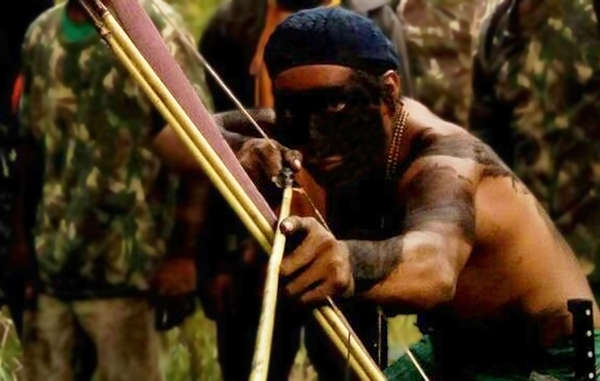
by Deep Green Resistance News Service | May 22, 2018 | Defensive Violence
Featured image: Guardians of the Amazon from the Guajajara tribe: “We patrol, we find the loggers, we destroy their equipment and we send them away. We’ve stopped many loggers. It’s working.” © Guardians of the Amazon
by Survival International
Members of an Amazon tribe patrolling their rainforest reserve to protect uncontacted relatives from illegal loggers have seized a notorious logging gang, burned their truck, and expelled them from the jungle.
The Guardians of the Amazon are from the Guajajara tribe: “We patrol, we find the loggers, we destroy their equipment and we send them away. We’ve stopped many loggers. It’s working.”
The area they are defending, Arariboia, is in the most threatened region in the entire Amazon. It is home to an uncontacted group of Awá Indians, a tribe well known for their affinity with animals and understanding of the forest, who face total annihilation if they come into contact with the loggers.
The Guardians have recently found abandoned Awá shelters close to where the loggers operate.
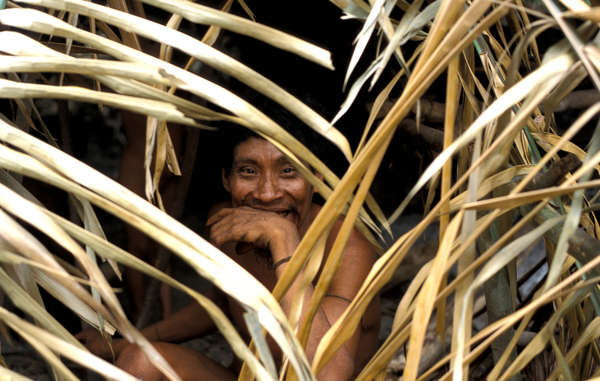
An Awá man called Takwarentxia, who was contacted in 1992 with his wife Hakõa’ĩ, and their baby. The rest of his family were killed by gunmen working for ranchers clearing the land. © Fiona Watson/Survival
They now fear violent retaliation. Three of the Guardians were murdered by loggers in 2016, and they have experienced arson attacks and regular death threats.
Burning Truck from Survival International on Vimeo.
The Guardians sent footage of the burning truck loaded with illegally cut timber to Survival International, along with the message: “Please show the world the reality we face. We know it’s risky and we have enemies but now’s no time for hiding. We want you to release this to the world so we can continue to protect our forest.”
Survival International has written urgently to the Brazilian government calling for the immediate and long term protection of both the Guardians themselves and of the area they fight to protect. Survival are also asking members of the public to send emails in support of the Guardians to government ministers via this page on their website.
Survival’s Director Stephen Corry said: “Tribal territories are the best barrier to deforestation, and these Guardians are defending the last patch of green amid a sea of destruction. It’s further proof that tribal peoples are the best conservationists and guardians of the natural world. The Guardians are virtually the only people standing between the loggers and the uncontacted Awá who still hold out in this forest. The Brazilian government’s inaction in the face of rampant illegal deforestation is shameful.”
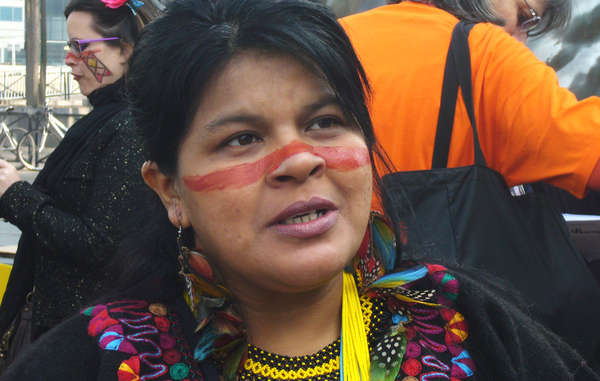
Sônia Guajajara at a protest in Paris against Brazil’s plans for a series of mega-dams in the Amazon, March 2014. © Survival International
She said today: “The Guardians’ work is both extremely valuable and incredibly risky. We indigenous peoples will never accept the ransacking of our Mother Earth – we listen to her and understand the way she talks to us because our life depends on her.”
BACKGROUND BRIEFING
The Guardians of the Amazon
– The “Guardians of the Amazon” are men from the Guajajara tribe in Brazil’s Maranhão state who have taken it upon themselves to protect what remains of this eastern edge of the Amazon rainforest.
– They want to save the land for the hundreds of Guajajara families who call it home, and their far less numerous neighbors: the uncontacted Awá Indians.
– The Guardians say of their work: “We patrol, we find the loggers, we destroy their equipment and we send them away. We’ve stopped many loggers. It’s working.”
– The Guardians recently released video and images of a rare encounter with the uncontacted Awá living in Arariboia. Watch the footage here
– You can see videos of several of the Guardians talking about their work on Survival’s Tribal Voice site.
Uncontacted tribes
– There are more than 100 uncontacted tribes worldwide. They have decided not to engage in regular contact with anyone from the outside world.
– They are not “lost” or trapped in a land that time forgot. They are aware of the outside world, and may engage sporadically with contacted tribes nearby.
– There’s irrefutable evidence that their tribal territories are the best barrier to deforestation, particularly in the Amazon rainforest.
– Uncontacted tribes are the most vulnerable peoples on the planet. Whole populations are wiped out by violence from outsiders who steal their land and resources, and by diseases like the flu and measles to which they have no resistance.
– It is not uncommon for 90% of the population to be wiped out following initial contact.
Awá
– The Awá are a hunter-gatherer people living in the forests of the eastern Brazilian Amazon
– While some Awá are in contact with the outside world, others are uncontacted.
– The Awá were known as “the most threatened tribe in the world” during a successful campaign by Survival International for the Brazilian government to expel the illegal loggers from one of their territories.
– The tribe are known for their affinity with the animals of their forest, and some families have more pets than people, from raccoon-like coatis to wild pigs and king vultures.
– Monkeys are the Awá’s favorites and individuals are often seen with their pet monkey riding on their head. Awá will rescue orphaned baby monkeys and adopt them as a member of the family, even breastfeeding them.
Arariboia
– The Arariboia indigenous territory comprises a unique biome in the transition area between the savannah and the Amazon rainforest.
– There are species here not found elsewhere in the Amazon.
– The land inside the indigenous territory is under threat from illegal loggers
– Brutal cuts in government funding to its indigenous affairs department FUNAI and tribal land protection mean the dangers are now even greater, as the area is not properly monitored or defended by the authorities.
– A powerful and violent logging mafia operates in the region, supported by some local politicians.

by Deep Green Resistance News Service | May 16, 2018 | Colonialism & Conquest
by Sebastián Ortega and Jhonny Valle Ayuque / openDemocracy via Intercontinental Cry
Leader of the Shipibo-konibo community, Olivia Arévalo Lomas, was 81 years old when she was shot in the chest and murdered. The principal suspect, Canadian Paul Woodroffe, died a few hours later.
The leader, practitioner of traditional medicine and defender of the Peruvian Amazon, Olivia Arévalo Lomas, of Shipibo-konibo ethnicity, was 81 years old when she was murdered last Thursday by two 380 calibre shots to the chest.
The main suspect, Canadian Paul Woodroffe died shortly after: a group of community members dragged him through the streets and beat him to death.
Olivia was a known shaman of Victoria Gracia, an intercultural settlement in the district of Yarinacocha. “Her death is an aggression against the entire Shipibo community. She was the living memory of her people” explained Juan Carlos Ruíz Molleda, coordinator of the department of indigenous communities and constitutional litigation of the NGO Institute of Legal Defence.
THE DAY THAT THEY MURDERED OLIVIA, ANOTHER WOMAN FROM THE SHIPIBO COMMUNITY, MAGDALENA FLORES AGUSTÍN, RECEIVED AN ANONYMOUS ENVELOPE AT HER HOME. INSIDE THERE WERE TWO BULLETS AND A LETTER DIRECTED TO HER AND HER HUSBAND.
It was not only members of her own Shipibo community, a village of more than 35,000 people that inhabit the amazon rainforest of Peru that turned to the guardian. She also attended to dozens of tourists who sailed for more than 15 hours down the river Ucayali to cure themselves of illnesses and to treat addictions.
“She was a grandmother who worked with medicinal plants”, Wilder Muñoz Díaz told Cosecha Roja, a traditional Shipibo doctor from a nearby community that shared healing ceremonies with Olivia. “It was very painful for us finding about her death”, he added.
Despite the main leads regarding the crime having discarded the possibility it might have been a political crime, indigenous communities have remained on alert.
The murder of the Amazonian guardian occurred in a context of territorial conflict between the Shipibo community and companies that desire to take over their land to cultivate palm oil.
The exploitation of the Peruvian amazon “affects the subsistence” of every community within the region explains Ruíz Molleda. They contaminate rivers where people wash themselves and fish, and they destroy the land in which the animals they hunt live.
In the past few years, around 6000 hectares of rainforest were deforested by companies who were operating illegally.
“The communities don’t want to sell their lands and that’s when hitmen start appearing”, according to Ruíz Molleda. In 2013 Mauro Pío Peña, historic leader of the Ashaninka community, was murdered by two hitmen.
The following year, Edwin Chota Valera, Leoncio Quintisima Meléndez, Francisco Pinedo Ramírez and Jorge Ríos Pérez, leaders from the Ashaninka community, were also murdered.
The suspicions point to wood extraction entrepreneurs that illegally exploit the amazon rainforest and drug traffickers who had threatened them. In 2015, other leaders and members of the Shipibo community of Santa Clara de Uchunya were threatened.
The day that they murdered Olivia, another woman from the Shipibo community, Magdalena Flores Agustín, received an anonymous envelope at her home. Inside there were two bullets and a letter directed to her and her husband: “you have 48 hours to leave here. One bullet for each of you”.
The investigators of the crime are following two leads: according to the first version, on the 19th of April the Canadian Woodroffe arrived at Olivia’s house by motorbike. When she left to go to the shops he shot her twice in the chest.
Two days later the police found the body of the Canadian buried on their terrain. They arrived there after discovering a video on social media in which several men can be seen lynching Woodroffe.
The investigators suspect that the neighbours of the leader caught him when he tried to escape and they dragged him with a rope around his neck whilst they beat him. Yesterday, the Supreme Court of Justice of Ucayali ordered the capture of the two men who appear in the video.
“What happened with the supposed suspect of the murder of Olivia Arévalo is not indigenous justice and it has nothing to do with it” explained Ruíz Molleda.
The Peruvian constitution establishes that the authorities within indigenous and rural communities may carry out justice in their own territory according to their customs. “But always with respect for human rights”, explained the lawyer of the NGO Legal Defence.
The Shipibo Konibo Xetebo Council (Coshicox), the highest authority within the Shipibo – Konibo – Xetebo community, condemned the crime and declared that justice is compatible with indigenous culture.
The Federation of Native Communities of Ucayali and Alfluentes (Feconau) also asked the state to provide guarantees to other indigenous leaders that receive death threats and harassment.
This article was originally published at OpenDemocracy and re-published at IC under a Creative Commons License.
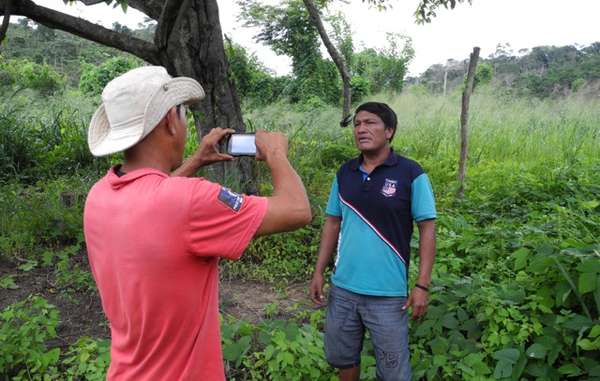
by Deep Green Resistance News Service | May 11, 2018 | Indigenous Autonomy
Featured image: With support from Survival, the Guajajara are able to expose illegal logging and threats to their uncontacted neighbors in real time. © Survival
by Sarah Shenker / Survival International
“We are here,” says Olimpio, looking directly into the camera, “… Monitoring the land and protecting the uncontacted Indians and the Guajajara who live here. Why? Because there are some people – anthropologists from some countries – who want, once again, to violate the rights of the uncontacted Indians in the country.”
Olimpio remains calm, but you can sense tension as he continues to speak.
“We are aware that some anthropologists have been calling for ‘controlled contact’ with the uncontacted Indians… We will not allow this to happen, because it would be another genocide.”
Olimpio is among the leaders of a group known as the “Guajajara Guardians,” men from the Guajajara tribe in Brazil’s Maranhão state who have taken it upon themselves to protect what remains of this north-eastern edge of the Amazon rainforest, the hundreds of Guajajara families who call it home, and their far less numerous neighbors: the Awá Indians, some of whom are uncontacted.
Uncontacted tribes are the most vulnerable peoples on the planet, and the Guajajara are acutely aware of this. Whole populations are being wiped out by violence from outsiders who steal their land and resources, and by diseases like flu and measles to which they have no resistance. The Guajajara know that the destruction of the forest, which the Awá have been dependent on and managed for generations, spells doom for the Awá and the Guajajara alike. All uncontacted peoples face catastrophe unless their land is protected. Without it, the Awá simply won’t survive.
The satellite imagery is startling: this territory, known as Arariboia, is an island of green amidst a sea of deforestation in this corner of the Amazon, which has been plundered for its iron ore; opened up by roads and rail; and chopped down for its valuable hardwoods.
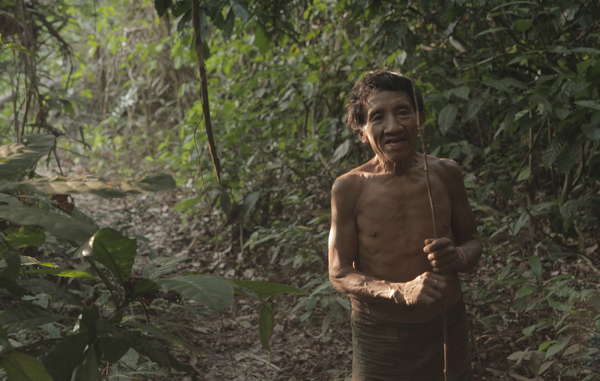
The Awá are one of the most vulnerable peoples on the planet. Some of them have no contact with mainstream Brazilian society, though the majority do. © Survival International
The uncontacted nomadic Awá live on a small hill in the centre of this island, where they hunt, fish, and collect fruits and berries. Its forest cover is thicker than that below. Following centuries of invasion, the Awá’s hill has become their refuge. They now number no more than several dozen.
As we looked up towards the uncontacted Arariboia Awá’s forest, it struck me that they really are living on the edge. Following centuries of land invasion and theft, and genocidal violence, they are clinging on against all odds. Preventing their annihilation is a matter of now or never.
I was here to learn about the Guajajara Guardians’ work and to set them up with communications technology as part of Survival International’s Tribal Voice project, which allows remote tribal peoples to send video messages around the globe in real time. It is one of the ways in which we work in partnership with them, and give them a platform to speak to the world. They were very enthusiastic about the possibilities this might offer, allowing them to expose logging and other attacks on Arariboia, and share information from their expeditions to protect their Awá neighbors.
First of all, however, Olimpio decided to record a denunciation of two American academics, Kim Hill and Robert Walker, rejecting outright their calls for forced contact with uncontacted tribes.
“It would be another genocide of a people, of indigenous people, who do not want contact, either with us, or with non-indigenous people” he says. It is hard not to be impressed by his determination.
*
Much of this region of Maranhão doesn’t really feel like the Amazon. The state borders the northeastern coast of Brazil and stretches downwards into the Amazon basin, but you don’t see the thick forests that people generally imagine when they picture the world’s largest rainforest. Instead, much of the area has been given over to agriculture in the form of ranches and plantations, or abandoned after the loggers have had their way with it and moved on.
After driving through countless miles of bleached brown grass, it is refreshing to reach Arariboia. The indigenous territory is home to the Guajajara and Awá peoples. Arariboia and other indigenous territories in the region are virtually the only remaining areas of genuine forest in the state. Crossing the border into indigenous land, things don’t feel all too different at first – in fact, vast swathes of forest in the territory were destroyed by fires last year, believed to have been started by the region’s powerful logging mafia. But the further into the area you head, the more you get the sense that you are in an island of lush greenery in the middle of the destruction so common elsewhere in this part of Brazil.
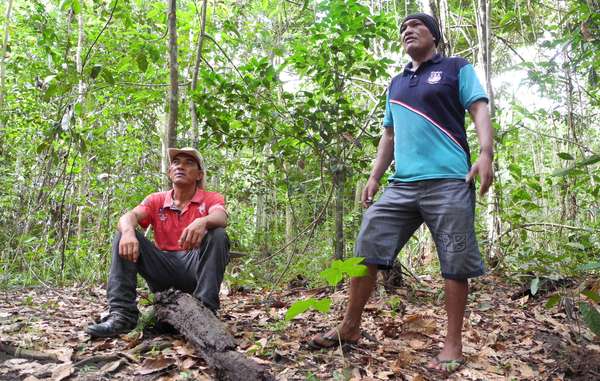
Olimpio and Franciel, coordinators of the Guajajara Guardians, are determined to protect the forest for their uncontacted Awá neighbors. © Survival
Although it is strictly forbidden under Brazilian law for outsiders to fell trees in indigenous territories, here and elsewhere in the Amazon loggers constantly flaunt this with impunity. Just on the drive up to Arariboia we passed dozens of loggers, their trucks piled high with illegally felled logs. I took a photo of one truck driven by two young men looking particularly pleased with their collection, and realized very quickly that they didn’t care. They do not attempt to hide their faces or their operations as they knew that the local government – largely controlled by the mafias who run this trade – will carry on turning a blind eye.
However, it is harder than ever for bandit loggers to operate in Arariboia. The Guardians, of whom there are around fifty, patrol the forest, monitoring, keeping their eyes open, and notifying the authorities. They do it in shifts, in their own time, with only sporadic financial and logistical support from the Brazilian government, despite its formal commitment to protecting the rainforest and indigenous rights. The work is time-consuming and far too much for a small band of committed volunteers. And it’s dangerous: In recent years, several Guajajara have been assassinated.
Why then, do they do it? I found it difficult to fathom at first. It is common for loggers to intimidate and murder indigenous people, so many feel forced into silent acceptance of the loggers and their activities. Sadly in this part of Brazil, many Guajajara also collaborate with the loggers, hoping to make some money from the trade, which they see as unstoppable. Alienated, threatened, and living on the fringes of a society that barely accepts them, the Guardians’ motivation for self-imposed vigilante duty is not outwardly obvious.
*
The more time I spent with the Guajajara in Arariboia, however, the more it seemed to make sense. Members of the tribe who live in the center of their land, closest to the Awá’s hill, are less integrated into mainstream Brazilian society, and feel a stronger sense of connection to their communal ways. They thrive in the forest, knowing it intimately and practising Guajajara rituals.
While I was there I witnessed one of these – a coming of age ceremony for a Guajajara girl. The tribe considers a girl’s first menstruation to be a hugely significant time, marking the passage into adulthood, and celebrate it as a community. The girl spent a week living in a small hut with a palm frond roof, attended by female relatives who would bring her food. Rather than being a solemn isolation, however, the rite of passage is a great celebration, and the Guajajara frequently burst into song and dance, paint their faces and revel in the girl’s new maturity. The men of the village, though not allowed to enter the hut, often come and stand close to the entrance and join in the singing.
Experiencing this put the Guardians’ desire to protect their forest and fellow indigenous people into context. To them, Arariboia is not a resource to be exploited in the name of “progress” and “civilization” – it is fundamental to who they are. They take great pride in it, protect what is left of it, and feel a deep sense of connection to it.
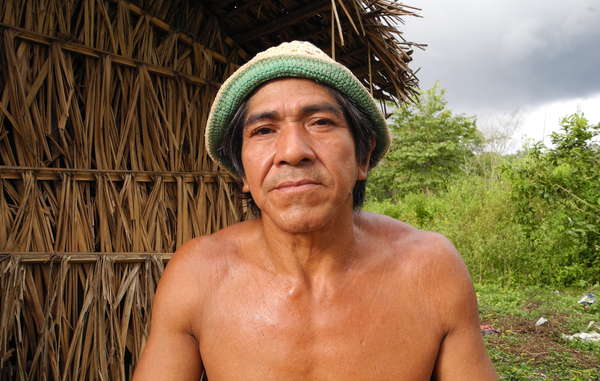
Survival has been working with the Guardians since 2015. © Survival
“People can’t take their land away from them,” another of the Guardians said to me, outraged, as we trekked through the forest close to one of the logging hotspots, “and they can’t take them away from their land.” He was indicating the Awá’s hill, which towers over the surrounding scrubland and lighter forest and provides a focal point in the landscape. The uncontacted Awá living there have expressed their desire to remain uncontacted, and the Guajajara want to see that desire respected.
Some see the centuries-long battle for survival between the indigenous peoples of the Amazon and the colonizers who exploit and destroy it as hopeless. Some, including the American anthropologists who the Guajajara were so keen to refute, see contact as inevitable and isolated uncontacted peoples as doomed. Deforestation will continue, they claim, and so tribal people will either have to assimilate with the Brazilian mainstream, or else face annihilation.
The Guajajara Guardians see it differently. They know what contact, “development,” and “progress” can mean for tribal peoples. They have watched as more and more of the forest that their ancestors were dependent on and managed for generations has been destroyed. And they’re keen to fight back, by boosting their land protection expeditions which are succeeding in keeping loggers out of some key areas, and by sharing their concerns with the world and encouraging international support.
For any tribal people, land is the key to survival. We’re doing everything we can to secure it for them, and to give them the chance to determine their own futures.
That’s also why Survival is giving the Guajajara, and other tribes, communications technology so they can speak to the world in real time. Their understanding of the problems they and their neighbors face is as astute as anyone’s and they have perceptive things to say about almost every aspect of life today. They are not only the best conservationists and guardians of the natural world, but are also at the forefront of the fight for human rights and self-determination. Maybe it’s time to listen.
Sarah Shenker was in conversation with Survival’s Lewis Evans
Act now to support the Guajajara Guardians
by Deep Green Resistance News Service | Apr 30, 2018 | Protests & Symbolic Acts
by Survival International
Thousands of indigenous people gathered in Brazil’s capital this week, to protest against plans to destroy their lands and lives.
The Indians, from tribes across the country, painted the streets with “blood,” marched through the city, demonstrated at government buildings, and called for their rights to be respected.
Sonia Guajajara, an indigenous leader and candidate for the Vice-Presidency in Brazil’s upcoming general election, said: “We are denouncing the genocide of our people…This is the most suffering we’ve experienced since the dictatorship. By staining the streets red, we are showing how much blood has been shed in our fight for the protection of indigenous lands… The fight goes on!”
The protest marks Brazil’s “Indigenous April” and follows the annual “Day of the Indian,” 19 April, when the country’s President often announces some progress in the protection of indigenous peoples’ ancestral lands. This year, no such announcements were made. Instead, it was reported that the head of the government’s Indigenous Affairs Department would be replaced, as he was not fulfilling the demands of anti-indigenous politicians and ranchers.
Politicians linked to the powerful agribusiness lobby are pushing through a series of laws and proposals which would make it easier for outsiders to steal indigenous peoples’ lands and exploit their resources.
This would be disastrous for tribes across the country, including the Guarani, who suffer one of the highest suicide rates in the world, as most of their land has been stolen for cattle ranching and soya, corn and sugarcane plantations.
Adalto Guarani told Survival International of the politicians’ plan: “Please help us destroy this! It’s like a bomb waiting to explode, and if it explodes, it will put an end to our very existence. Please give us a chance to survive.”
And uncontacted tribes, the most vulnerable peoples on the planet, could be wiped out if their lands are opened up. Tribes like the uncontacted Kawahiva and Awá are on the brink of extinction as they live on the run, fleeing violence from outsiders. But if their land is protected, they can thrive.
Survival International and its supporters in over 100 countries are working in partnership with tribes across Brazil to prevent their annihilation and the extinction of their uncontacted relatives.













